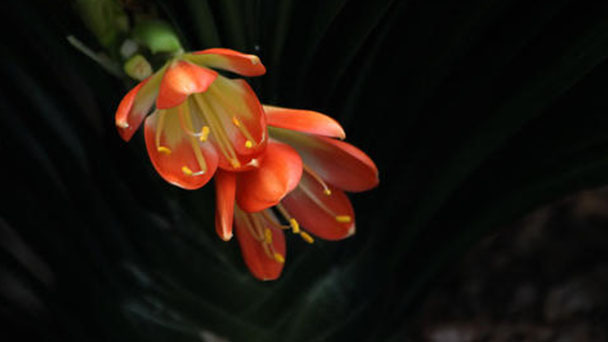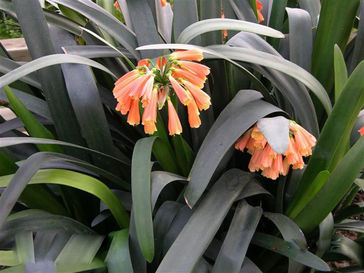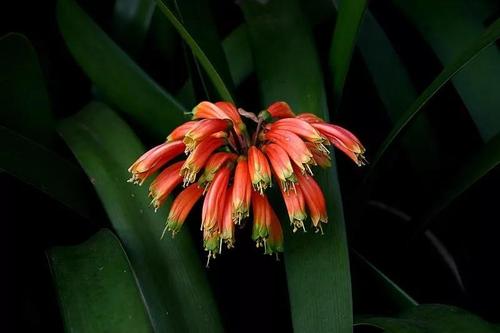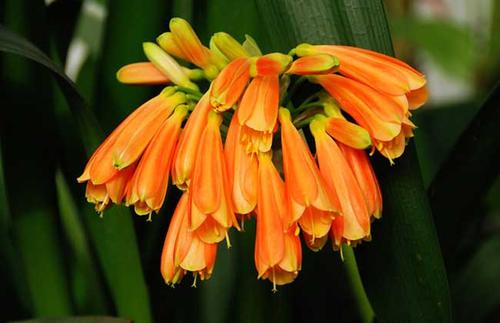Clivia nobilis (green-tip forest lily) profile
Written by Maggie
Sep 11 2021

Green-tip Forest Lily (Clivia Nobilis Lindl.), a species of the genus Green-tip Forest Lily in Lycoris family, is distributed in southern Africa and Hubei Province of mainland China, and has been artificially introduced and cultivated. Green-tip Forest Lily height is 38 cm, flowers drooping, orange yellow, and with a little green, long and narrow leaves, stems slightly shorter than leaves, leaves dark green, elegant and solemn appearance.
Green-tip forest lily picture

Morphological characteristics of green-tip forest lily
Clivia nobilis (green-tip forest lily) is a perennial herb. The roots are fleshy, grayish white.
The persistent leaf bases in the stem base of clivia nobilis (green-tip forest lily) are bulbous. Basal leaves about a dozen, thick, dark green, shiny, banded, 25-40 cm long, 3-3.5 cm wide, rough edges.
The flower stem of Clivia nobilis (green-tip forest lily) is extracted from the leaves, which is slightly shorter than the leaves. Umbel terminal, with 10-30 florets, each floret 6 petals, 6 stamens and 1 pistil.
The colors of Clivia nobilis (green-tip forest lily) are orange yellow, orange red, dark red and so on. Many flowers, slightly drooping when flowering; Perianth of Green-tip forest lily is narrowly funnel-shaped, orange red, inner perianth lobes lighter in color; Stamens subequal to perianth;Style long, slightly extruding from perianth.
The flowering period of Clivia nobilis (green-tip forest lily) is 30-50 days. The berries and fruits are green when immature, and the seeds take 8-9 months to mature.
Ecological habits of the Green-Tip Forest Lily
Clivia nobilis (green-tip forest lily) likes a warm and cool environment. Clivia nobilis (green-tip forest lily) needs plenty of sunshine in winter and a little shade in summer. Green-tip Forest Lily requires loose and fertile leaf rot soil. When the room temperature is lower than 5℃ in winter, it stops growing or when it is higher than 30℃ in summer.
Clivia nobilis (green-tip forest lily) requires air humidity of 70%-80% and soil moisture of 20%-30%. Too much soil moisture is easy to rot roots.
Green-Tip Forest Lily propagation
Splitting and sowing propagate. Every spring after flowering, the mother plant next to the daughter plant takes off the branch. If there is no fleshy root on the seed plant, it can be inserted into the sand first, and then loaded in the basin after taking root.
Sow seeds of Clivia nobilis (green-tip forest lily) in indoor pots in winter. The room temperature should be above 20℃, otherwise the seeds are easy to rot. After sowing 20-25 days germination, seedling cultivation 4-5 years before flowering.
How to grow and care for Green-tip Forest Lily
Soil
Clivia nobilis (green-tip forest lily) is suitable for the soil with abundant humus, which has good air permeability, good water permeability, and fertile soil quality, with a slightly acidic pH of 6.5.
Infiltration of about 20% sand in humus soil is conducive to raising roots. Cultivation with the pot with the plant growth and gradually enlarged, cultivation of annual seedlings, suitable for 3 inch basin.
In the second year for a 5 inch pot, 1-2 years after the change into a larger pot, pot can be in spring, autumn.
Plant
With points Nie seedlings planted into the pot loaded with good nutrition soil, generally a diameter of 25 centimeters in the size of the pot only 1 plant.
If the seedling of Clivia nobilis (green-tip forest lily) does not have a well-developed bulb, Green-tip Forest Lily should be first planted in the sand, and then transplanted into the pot after cultivating a good root system.
Because planting directly into the pot installed above is not good for roots, if there is no condition to find sand it can also be directly planted in the pot, but it takes a little longer time.
Seeded bulbs generally germinate 20-25 days after sowing; Sowing seeds should first use warm water about 40℃ soaking seeds for about 24 hours, seeds sowing in the topsoil 0.5-1 cm, with the seed hole down, the posture of the stomach and back upward placed seeds of Clivia nobilis (green-tip forest lily), pouring permeable after the best covered with plastic film or glass in order to improve the ground temperature to promote seed germination; If the temperature is too low, the seeds of Clivia nobilis (green-tip forest lily) can not come out late and rot easily. When the temperature is about 20℃, it will germinate in about 60 days, and the seedlings can blossom in 3-5 years.
Fertilization
Clivia nobilis (green-tip forest lily) likes fertilizer, but too much fertilizer will cause rotting roots. In addition to base fertilizer, top dressing should adopt the method of "thin fertilizer and more fertilizer". Apply base fertilizer when changing pots.
Spring and autumn every other month after the application of solid fertilizer, and then a weekly application of liquid fertilizer, it is best not to top fertilizer, the whole Clivia nobilis can rely on the accumulation of nutrients in spring and autumn slow growth solid fertilizer, dug open the basin soil, buried in the soil 2 cm deep, do not directly contact the root system so as not to burn;When applying liquid fertilizer, small seedlings to fertilizer: water 1:40 is better, large and middle flower 1:20 is better, fertilization time in the early morning is appropriate, avoid splashing on the leaves, after applying liquid fertilizer should be promptly watered 1 time, but the water need not be too much, on the one hand dissolve fertilizer, on the other hand can grow the new fleshy root, rinse, in order to prevent damage to the new root.
Different seasons, fertilizer types have some emphasis. Phosphorus and potassium fertilizer, such as bone meal, should be applied in winter and spring. Autumn partial application of nitrogen fertilizer, such as bean cake water;
Extra-root topdressing is commonly used in summer, and leaves of Clivia nobilis (green-tip forest lily) are sprayed with 0.1% potassium dihydrogen phosphate or calcium superphosphate. Extra-root topdressing can be carried out all year round.
Light
Try to keep the Clivia nobilis (green-tip forest lily) out of direct sunlight throughout the growing process. Only about four hours a day of scattered sunlight is enough. Excessive sunlight can narrow the leaves.
Clivia nobilis (green-tip forest lily) should not be exposed to high temperature and hot sun in summer. Green-tip Forest Lily should be placed in a shady environment with high air humidity and pay attention to ventilation.
In winter, Clivia nobilis (green-tip forest lily) is afraid of cold, so it should be moved indoors and placed in a well-lit place. Green-tip Forest Lily can survive the winter safely at about 5℃ at room temperature.
If possible, it is best to keep the ambient temperature stable between 15-25℃.
The temperature
The suitable temperature of Clivia nobilis (green-tip forest lily) is 15-20℃. When the temperature is higher than 25℃, plant growth is poor, and leaf length is often empty, which affects flower bud differentiation. At this time, attention should be paid to ventilation and cooling. The growth is slow when the temperature is lower than 10℃. When the temperature drops below 0℃, the plant will freeze to death.
Summer should pay attention to cooling, and can promote flower bud differentiation. The temperature difference between day and night is large, which is beneficial to the growth of clippies. Generally, 6-10℃ is the best temperature.
Leaves of Clivia nobilis (green-tip forest lily) are oblique to both sides of the upper growth, and into a fan-shaped arrangement. During curing, the direction of illumination can be adjusted so that the extension direction of the leaves is parallel to the direction of illumination, that is, the tip of the leaves on one side is pointed to the light source, and the tip of the leaves on the other side is pointed to the window in the room. The flowerpot is turned 180 degrees every other week so that the tip of the leaves on the other side is pointed to the window.
In this way, the growing leaves are arranged neatly, like an open fan from the front, and like a line from the side.
It also is in the seedling growth after a year, with the frame of the bent wire, the blade is stuck in the inside to control, a year later to remove the wire frame, so as to prevent the leaves growing seven twisted eight crooked. If there is individual leaf deflection, black paper can be used to paste a paper cover to cover it, 10-15 days can naturally straighten.
Watering
Potted Clivia nobilis (green-tip forest lily) should not be too much water, in order to wet line.
Summer high temperature periods pay attention to water cooling. Autumn proper topdressing to promote leaf growth.Warm up the soil in winter and keep it moist for flowering.

Disease control of green-tip forest lily
The main diseases of Clivia nobilis (green-tip forest lily) are soft rot, anthracnose, leaf spot, white silk and so on, and the main pests are scale insects.
Dry spot
The main damage to the leaf, primary light red brown, elliptic long spot disease health interface obvious, around the organization becomes yellow.
The diseased leaves of Clivia nobilis (green-tip forest lily) were cut off in time when found. Appropriate increase of potassium fertilizer, to avoid excessive water on the leaves; At the beginning of the disease, spray 50% carbendazim wettable powder 1000 times liquid.
Root rot (soft rot)
During the cultivation process, tools and substrates should be strictly disinfected; Roots of Clivia nobilis (green-tip forest lily) were irrigated with 400-600μg/L penicillin and streptomycin at the early stage of onset.
In severe cases, the rotted part will be completely removed, and the remaining part will be soaked in potassium permanganate solution for 1 hour, and then washed with clean water, and replanted.
Burning disease
Leaves of Clivia nobilis (green-tip forest lily) all turn yellow, caused by long periods of intense sunlight in summer. It should be shaded cultivation, yellowed leaves can be cut off.
Anthrax
The disease mostly occurs in wet and rainy seasons, and the spots are mostly in the middle and lower leaf margins. At the beginning of the disease, there are small moist brown spots on the leaf, followed by. Clivia nobilis (green-tip forest lily) gradually expands into elliptic disease spots, and produces concentric rings on the disease spots. Later, the disease spots are dry, and many small black spots are scattered on them.
Prevention method, it is late autumn or early spring clear dead branches. Fallen leaves and timely cut off the diseased branches, along with the burning;
Before the onset of spraying 65% of the Dessen zinc 600 times liquid protection;
Reasonable fertilization and watering, pay attention to ventilation and light;
The onset of the initial spraying 500 ~ 800 letter of 50% carbendazim, or 50% tobuzin fluid, or with the dilution of 600 ~ 800 times 75% chlorothalonil liquid spray.
The "clip arrow" disease
In the cultivation of Clivia nobilis (green-tip forest lily), the phenomenon of failing to draw out the flower-stalk after pregnant bud and failing to blossom is often occurred, which is called "clip arrow".
It has to do with temperature and fertilizer. The main reason for clamping arrows is that the temperature is not appropriate.
The flowering period of Clivia nobilis (green-tip forest lily) is mostly from winter to spring. At this time, if the room temperature is lower than 14℃, the temperature difference between day and night is very small, and the flowers grow slowly after being pulled out, causing the phenomenon of clip arrows.
The solution is: when flowers and plants appear, the room temperature should be immediately raised to more than 20℃, the room temperature at night is better at about 12℃, so that the temperature difference between day and night to reach more than 18℃, can prevent the arrow.
25℃ warm water can also be poured into the soil to urge the arrow. Room temperature is too low when, usable plastic film makes the frame child cover outside the flower pot, placed below sunshine, urge in order to increase temperature "arrow".
Improper management of fertilizer and water will also cause the phenomenon of "clip arrows", so before the flower to apply enough fertilizer, to promote the growth of flowers and buds have enough nutrients.
Clivia nobilis (green-tip forest lily) need enough water to grow quickly, so keep the soil moist and fertilized with a small amount of liquid fertilizer before Clivia nobilis (green-tip forest lily) blooms.
Scale insect class
Available artificial control, with bamboo sticks, small sticks, small soft brush, etc., gently insect body and soot like brush, and then clean with clean water.In the nymphal stage, a 40-100 times liquid of acaridin was sprayed.
The distribution region of Green-Tip Forest Lily
Clivia nobilis (green-tip forest lily) is native to southern Africa.
Clivia nobilis (green-tip forest lily) is most cultivated in Beijing and its surrounding areas in China. More to introduce cultivation for ornamental.
Function and use of Green-Tip Forest Lily
Clivia nobilis (green-tip forest lily) is elegant and solemn, with long and narrow leaves, shorter stems and leaves, and orange flowers that droop in the shape of a barrel when they open. Green-tip Forest Lily is a potted flower used to decorate the meeting place, decorate the hotel and beautify the home environment during the Spring Festival.
The flower language of Green-Tip Forest Lily
Clivia nobilis (green-tip forest lily) stands for nobility and gentleman's style.

Latest Updated
- Benefits of Bugleweed - 7 Science-backed Health Benefits
- Bugleweed Dangers & Side Effects - Is It Poisonous?
- How to Plant Evergreen Trees - What You Should Know
- When to Plant Evergreens - Grow Guide for Evergreen Trees
- 12 Wonderful Evergreen Shrubs for Your Garden
- 12 Popular Evergreen Plants with Pictures for Beginners
- When And How To Prune A Lilac Bush Like a Pro
- How to Grow & Care for Lilac Vine (Hardenbergia Violacea)
- Japanese Lilac Tree (Syringa Reticulata) Care & Propagation Guide
- Shumard Oak Pros and Cons - What to Know
Popular Articles
- Winter maintenance of Antirrhinum Majus
- How to Grow Terminalia Mantaly Tree
- How to Grow and Care for Crossostephium Chinense
- How to grow Antirrhinum Majus in spring
- Peristeria Elata (Dove Orchid) Profile: Info & Care Guide
- Underwatered Snake Plant (Sansevieria Trifasciata) - Signs And How To Fix
- How to Care for Brazilian Jasmine Plant (Mandevilla Sanderi)
- How to Grow & Care for Graptopetalum Purple Delight in Summer
- Rosa Chinensis (China Rose): Plant Growing & Care Tips
- How to Care for Baby Sun Rose (Aptenia Cordifolia)